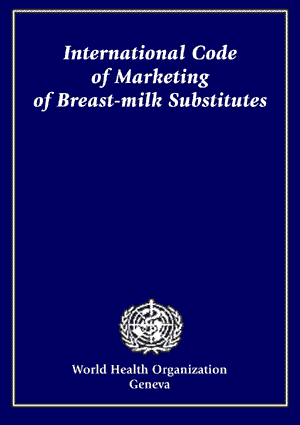International Code of Marketing of Breastmilk Substitutes
 The “International Code of Marketing of Breastmilk Substitutes” was developed by the WHO and UNICEF in 1981 in order to protect breastfeeding. The aim of this Code is to contribute to the provision of safe and adequate nutrition for infants, by the protection and promotion of breastfeeding, and by ensuring the proper use of breastmilk substitutes, when these are necessary, on the basis of adequate information and through appropriate marketing and distribution. Some of the basic rules set out by the Code to regulate harmful marketing practices are:
The “International Code of Marketing of Breastmilk Substitutes” was developed by the WHO and UNICEF in 1981 in order to protect breastfeeding. The aim of this Code is to contribute to the provision of safe and adequate nutrition for infants, by the protection and promotion of breastfeeding, and by ensuring the proper use of breastmilk substitutes, when these are necessary, on the basis of adequate information and through appropriate marketing and distribution. Some of the basic rules set out by the Code to regulate harmful marketing practices are:
- No advertising of breastmilk substitutes, feeding bottles and teats
- No free samples to mothers;
- No promotion of products in or through healthcare facilities;
- No company personnel to contact mothers;
- No gifts or personal samples to health workers. Health workers should never pass samples on to mothers;
- Labels should be in an appropriate language and have no words or pictures idealizing artificial feeding e.g. pictures of infants on the labels;
- All information on artificial infant feeding should clearly explain the benefits of breastfeeding, warn of the costs and hazards associated with artificial feeding;
- Manufacturers and distributors should comply with the Code (and all subsequent WHA resolutions) even if governments have not acted to implement it.
Download full text of the International Code
Code and subsequent resolutions
Background
The World Health Organization (WHO) and the United Nations Children’s Fund (UNICEF) have for many years emphasized the importance of maintaining the practice of breastfeeding as a way to improve the health and nutrition of infants and young children. Efforts to promote breastfeeding and to overcome problems that might discourage it are a part of the overall nutrition and maternal and child health programmes of both organizations. The 27th World Health Assembly (WHA), in 1974, noted the general decline in breastfeeding in many parts of the world, related to sociocultural and other factors including the promotion of manufactured breastmilk substitutes, and urged “Member countries to review sales promotion activities on baby foods to introduce appropriate remedial measures, including advertisement codes and legislation where necessary”. The issue was taken up again by the 31st WHA in May 1978. Among its recommendations were that Member States should give priority to preventing malnutrition in infants and young children by supporting and promoting breastfeeding, taking legislative and social action to facilitate breastfeeding by working mothers, and regulating inappropriate sales promotion of infant foods that can be used to replace breast milk. Governments, non-governmental organizations, professional associations, scientists, and manufacturers of infant foods have also called for action to be taken on a world scale as one step towards improving the health of infants and young children. In the latter part of 1978, WHO and UNICEF announced their intention of organizing jointly a meeting on infant and young child feeding, within their existing programmes, to try to make the most effective use of this groundswell of opinion. The 33rd WHA, in May 1980, endorsed in their entirety the statement and recommendations agreed by consensus at this joint WHO/UNICEF meeting and made particular mention of the recommendation that “there should be an international code of marketing of infant formula and other products used as breast-milk substitutes”. To develop an international code of marketing of breastmilk substitutes in accordance with the WHA’s request, numerous and lengthy consultations were held with all interested parties. Member States of the WHO and groups and individuals who had been represented at the October 1979 meeting were requested to comment on successive drafts of the code, and further meetings were held in 1980. In January 1981, the Executive Board of the WHO at its 67th session, considered the fourth draft of the code, endorsed it, and unanimously recommended to the 34th WHA the text of a resolution by which it would adopt the code in the form of a recommendation rather than as a regulation. In May 1981, the WHA adopted the code, as proposed, on 21 May by 118 votes in favour to 1 against, with 3 abstentions.
Frequently Asked Questions (FAQs)
“International Code of Marketing of Breastmilk Substitutes”FAQs (WHO, 2017 Update)
FAQs on the roles and responsibilities of health workers

